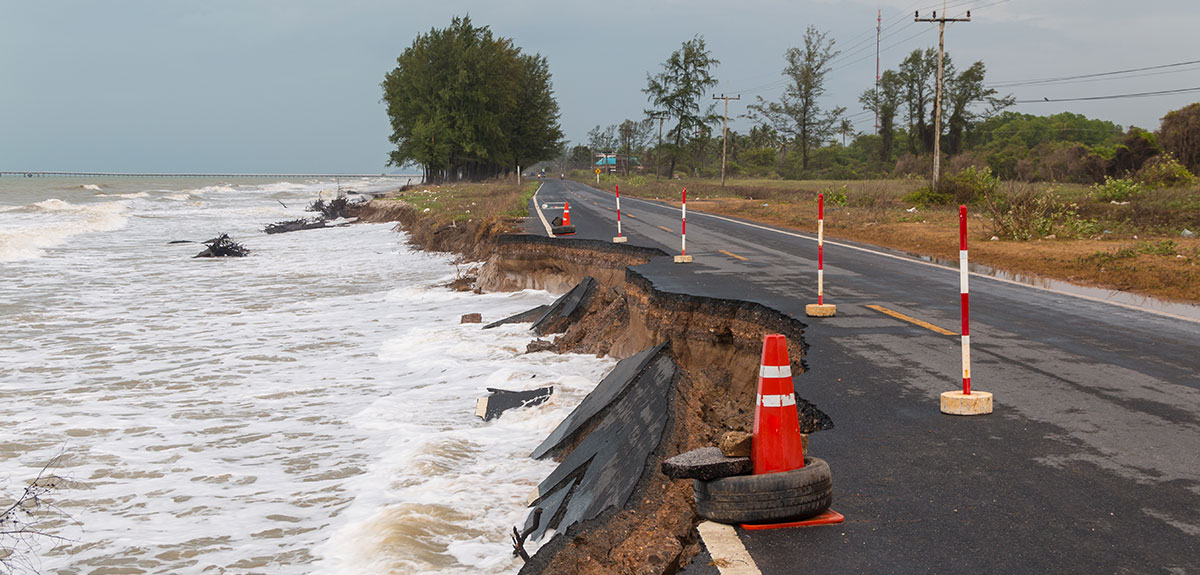Sea level rise, as it sounds, refers to the increasing sea level elevation. Since 1880, the average global sea level has risen around 8-9 inches. But the increase hasn’t been steady. The global average from 2006-2015 increased by about 0.6 inches per year. Since then, it’s increased by 0.14 inches.
With the coastal water levels continuing to grow exponentially, it is more important than ever to ensure your home and property are prepared for the water rise and its effects. Keep reading to learn more about sea level rise on the coast and how to protect what’s most important to you.
Causes and Factors That Affect Sea Level
Sea level rise is caused primarily by thermal expansion: ocean water expands as it heats up and melts large pieces of sea ice, such as glaciers. Excess greenhouse gases are one of the biggest catalysts for this phenomenon.
Oceans make up 71% of the earth’s surface area, so it makes sense that they would absorb most of the heat trapped in the atmosphere. Of the vast amount of water that covers the world, about 15% is frozen in the form of icebergs and glaciers. Significant sea level rise can still occur should that ice melt due to thermal expansion.
The Effects of Sea Level Rise
Significant environmental changes directly result from sea level rise. One of which is changes in weather patterns which can also mean extreme weather events. Changing ocean levels may cause coastal communities to experience severe droughts or hefty rainfall and increase the magnitude of tropical storms. Rising sea levels can also accelerate the rate of coastal erosion.
Erosion will naturally move further inland as the water level increases, and when this happens, it will wear away at natural and artificial structures. The last significant consequence of sea level rise is an increasing flood risk and an increase in the severity of flooding. This will significantly expand the area of homes exposed to flooding and lead to flood damage in communities where flooding was once not an issue.
Preparing for Sea Level Rise Through Adaptation
Although the rise in sea level is inevitable, the good news is that there are ways that coastal communities can adapt to the ever-changing landscape. Manufactured structures such as levees and seawalls can be added to protect homes and business buildings and reduce erosion’s effects.
When building and developing coastal areas, community officials should account for and plan for sea level rise. Shorelines can serve as the first level of defense from these harsh conditions via dunes, breakwaters, and vegetation. Lands prone to flooding can be designated as natural areas and wetland habitat preserves. This prevents the space from being developed, allowing it to serve as a raw buffer for floods and storms while offering a refuge for native flora and fauna that may also be harmed by sea level rise.
Protect Your Home and Property by Relocating or Lifting Your Foundation
Now that we understand the causes and effects of sea level rise, we can move to understand how individuals can protect themselves from water and weather damage. Home relocation is the best way to reduce risk and ensure the safety of one’s property and belongings. Water levels will continue to rise despite our best efforts, so moving your home to a safer location means that you can enjoy it the way you intended to. Any home on or near the coast can benefit from increased durability as ocean waters, flood waters, and storms continue moving closer to our neighborhoods and developed areas.
If total relocation isn’t appealing, homeowners can lift their home’s foundation to a safe height above sea level. This approach allows homeowners to remain on their property while securing safety and peace of mind.
Invest in Your Community and Build Back Stronger
In the same way that individuals can take steps to prepare their own homes and properties, communities can come together to protect and invest in their communities proactively. Resilience can be fostered by planning, including tin, updating, adhering to building codes, and staying informed on weather patterns and risks. If and when flooding and storm damage occurs, coastal communities should make an effort to repair and restore homes and buildings so they are better and stronger than they were before to strengthen and build endurance.
Conclusion
Global studies and statistics reflect an accelerating increase in sea levels. Staying informed on sea level rise and weather patterns will foster an attitude of safety in our coastal communities and allow us to make informed decisions on how to prepare. If you own a home near the coast, reach out to the experts at DeVooght House Lifters today to see how lifting or moving your home can protect your property and family from the dangers of rising sea levels.

